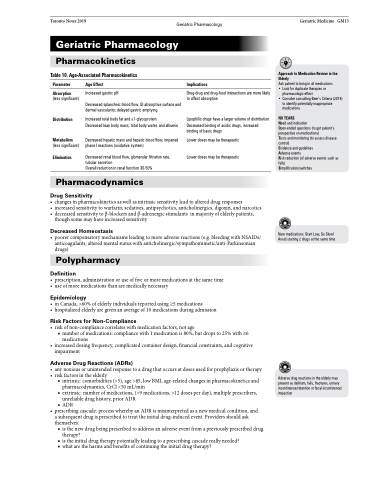Page 481 - TNFlipTest
P. 481
Toronto Notes 2019 Geriatric Pharmacology Geriatric Pharmacology
Geriatric Medicine GM13
Approach to Medication Review in the Elderly
Ask patient to bring in all medications
• Look for duplicate therapies or
pharmacologic effect
• Consider consulting Beer’s Criteria (2015)
to identify potentially inappropriate medications
NO TEARS
Need and indication
Open-ended questions (to get patient’s perspective on medications)
Tests and monitoring (to assess disease control)
Evidence and guidelines
Adverse events
Risk reduction (of adverse events such as falls)
Simplification/switches
New medications: Start Low, Go Slow! Avoid starting 2 drugs at the same time
Pharmacokinetics
Table 10. Age-Associated Pharmacokinetics
Parameter
Absorption
(less significant)
Distribution Metabolism
(less significant)
Elimination
Age Effect
Increased gastric pH
Decreased splanchnic blood flow, GI absorptive surface and dermal vascularity; delayed gastric emptying
Increased total body fat and α1-glycoprotein
Decreased lean body mass, total body water, and albumin
Decreased hepatic mass and hepatic blood flow; impaired phase I reactions (oxidative system)
Decreased renal blood flow, glomerular filtration rate, tubular secretion
Overall reduction in renal function 30-50%
Implications
Drug-drug and drug-food interactions are more likely to affect absorption
Lipophilic drugs have a larger volume of distribution Decreased binding of acidic drugs, increased binding of basic drugs
Lower doses may be therapeutic Lower doses may be therapeutic
Pharmacodynamics
Drug Sensitivity
• changes in pharmacokinetics as well as intrinsic sensitivity lead to altered drug responses
• increased sensitivity to warfarin, sedatives, antipsychotics, anticholinergics, digoxin, and narcotics • decreased sensitivity to β-blockers and β-adrenergic stimulants in majority of elderly patients,
though some may have increased sensitivity
Decreased Homeostasis
• poorer compensatory mechanisms leading to more adverse reactions (e.g. bleeding with NSAIDs/ anticoagulants, altered mental status with anticholinergic/sympathomimetic/anti-Parkinsonian drugs)
Polypharmacy
Definition
• prescription, administration or use of five or more medications at the same time • use of more medications than are medically necessary
Epidemiology
• in Canada, >60% of elderly individuals reported using ≥5 medications
• hospitalized elderly are given an average of 10 medications during admission
Risk Factors for Non-Compliance
• risk of non-compliance correlates with medication factors, not age
■ number of medications: compliance with 1 medication is 80%, but drops to 25% with ≥6
medications
• increased dosing frequency, complicated container design, financial constraints, and cognitive
impairment
Adverse Drug Reactions (ADRs)
• any noxious or unintended response to a drug that occurs at doses used for prophylaxis or therapy
• risk factors in the elderly
■ intrinsic: comorbidities (>5), age >85, low BMI, age-related changes in pharmacokinetics and pharmacodynamics, CrCl <50 mL/min
■ extrinsic: number of medications, (>9 medications, >12 doses per day), multiple prescribers, unreliable drug history, prior ADR
■ ADR
• prescribing cascade: process whereby an ADR is misinterpreted as a new medical condition, and
a subsequent drug is prescribed to treat the initial drug-induced event. Providers should ask themselves:
■ is the new drug being prescribed to address an adverse event from a previously prescribed drug therapy?
■ is the initial drug therapy potentially leading to a prescribing cascade really needed?
■ what are the harms and benefits of continuing the initial drug therapy?
Adverse drug reactions in the elderly may present as delirium, falls, fractures, urinary incontinence/retention or fecal incontinence/ impaction


